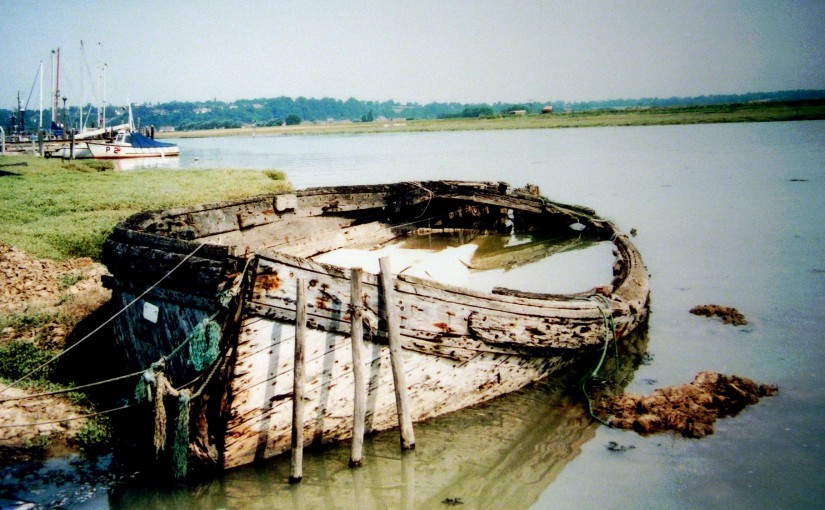The rescue of PRIMROSE The Last Rye Barge
On Sunday, 4 October 199t Rye Barge 2, the strangest sight met people’s eyes at Rye Harbour. A huge crane lifted an old boat out of the water and on to an 80 ft long flatbed truck which then drove very slowly to Hastings under police escort. There the boat was lifted again by crane into the back yard of the Shipwreck and Coastal Heritage Centre in Rock a Nore, where she has rested ever since.
 That old boat was Primrose, a very special Sussex-built craft, precious because she was the very last Rye barge to be made, and today is the only surviving example of her kind.
That old boat was Primrose, a very special Sussex-built craft, precious because she was the very last Rye barge to be made, and today is the only surviving example of her kind.
It is not known when Rye barges were first built, but the earliest mention in Rye town records was in 1531 when “Miles the lighterman was paid four shillings and a penny for bringing 6 tons of timber from Knelles Dam to Standens.” Then in 1572 John Prouze published the earliest known map of Rye that includes the first illustrations of the barges.
Rye’s prosperity depended on its port, and as a Cinque port its craftsmen supplied ships for mutual protection and trade. By the eighteenth century the river access to Rye had become silted up and the town lost its legitimate trade, so boatbuilders turned to providing ships for privateers, smugglers and Customs officials instead. Threats of invasion during the Napoleonic Wars ensured that boats continued to be built.
Barges were needed because they carried goods that were offloaded by ships too large to navigate the narrow rivers. So the tradition of constructing barges continued in Rye into the late nineteenth century, with Primrose being the very last. Eventually both railways and lorries sounded the death knell of the barges and, after four centuries, they disappeared.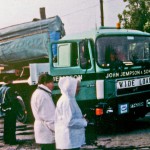
The barges were used for transporting cargoes to villages around Rye along the waterways of the Rivers Tillingham, Brede and Rother in Sussex, and the Royal Military Canal in Kent. They mainly carried coal, bricks, timber, stone, hop poles and other vital goods needed by residents, brick makers, builders and farmers in the countryside. They were designed specifically to carry these bulk goods. For instance, Primrose was 17.2m long, 4.7m wide, and flat-bottomed, with fairly straight sides. She had a single mast forward, with a cabin in front, and an open hold between the mast and the stern cabin. Under the forward deck there were two berths for crew, or “bargees”. There was a stove, and the single mast was set into a slot called a “step”. There was one lug sail.
Barges had to be sturdy, and when Rye shipmaker William Evans Clark built Primrose, he followed the traditional lines, but gave her extra strength by using two layers of planks that overlapped each other diagonally, called “double diagonal”. Primrose was built about 1885 on Winchesea Road by the River Tillingham. Clark owned three other barges – Violet, and Myrtle – and Water Lily, part of which survives in the mud in Rye today.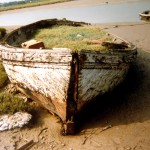
For instance, Primrose was 17.2m long, 4.7m wide, and flat-bottomed, with fairly straight sides. She had a single mast forward, with a cabin in front, and an open hold between the mast and the stern cabin. Under the forward deck there were two berths for crew, or “bargees”. There was a stove, and the single mast was set into a slot called a “step”. There was one lug sail. Barges had to be sturdy, and when Rye shipmaker William Evans Clark built Primrose, he followed the traditional lines, but gave her extra strength by using two layers of planks that overlapped each other diagonally, called “double diagonal”. Primrose was built about 1885 on Winchesea Road by the River Tillingham. Clark owned three other barges – Violet, and Myrtle – and Water Lily, part of which survives in the mud in Rye today.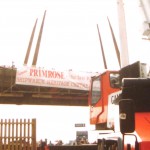
Clark’s boatyard was a family concern, which lasted over 60 years
and was handed down from father to son to nephew. William’s father,
Thomas Staffel Clark, was the founder and William was his carpenter.
The name Staffel suggests that Thomas was descended from a boatbuilding
family of that name which existed as far back as 1798. By 1878 William
was running the business. It was finally sold in 1909.
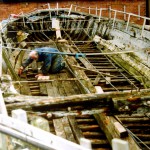
William was married firstly to Sabina Lilburn, and later to Margaret.There were nine children. William, Abel and David, the three oldest sons, all became shipwrights, whilst Samuel became a millwright. Other children were Margaret, Philip, Thomas, Mary and Sarah. All were born in Rye.
On 15 November 1928 another William Clark, and his brother Leslie, died in the terrible lifeboat disaster at Rye Harbour. Undoubtedly they were descendents of Primrose’s creator, William Clark. (If anyone has family history evidence of this, please contact SCHC).
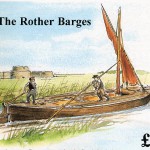
near Camber Castle
Just as shipbuilding ran in families, so also did the job of bargee. Often sons worked with their fathers to learn basic seamanship. A master was appointed and paid by the owner and his job highly skilled. At one time the closely-knit Axell family had three or four masters on the barges. Albert, Henry and Robert Cutting were brothers who worked the river, and they took Primrose with 27 tons of ballast from Rye Harbour mouth to Winchelsea. Sadly they, too, were lost in the Mary Stanford disaster. When new methods of transportation arrived, they not only killed the boatbuilding and bargee trades, but they ended a whole way of life forever. Primrose is the last representative of that tradition and that is why it was deemed so important to save her in 1992
. She was abandoned in the mud on the saltings at Rye Harbour in about 1935 and for at least 50 years she was submerged by strong tides twice a day. A combination of this, and the wash from passing shipping, filled the interior of Primrose with mud. A local resident pointed her out to the Nautical Archaeology Society and in early ’92 it was decided to save her right then because it was unlikely she would survive another winter. This was achieved under the direction of Valerie Fenwick and several volunteers, including Jimper Sutton.
Primrose now graces the backyard of the Shipwreck and Coastal Heritage Centre, where wire hawsers are in place to pull together her bulging sides. Primrose has just reopened to the public, and it is now possible to walk around her, admire her and learn about her history.
She is rare, she is unique, she is a centenarian and she is very, very special. Why not come and see for yourself? SCHC asks for only a £1 donation to see the displays about shipwrecks, the audiovisual show, the fossils (including sharks’ poo!) and the one and only real Rye barge. There is also a wonderful gift shop with an interesting selection of goods. SCHC is open seven days a week from 11am to 4.30pm. Try the website www.shipwreck-heritage.org.uk or phone 01424 437452 for more details.
“Hastings Town” May 2008
All articles, photographs and drawings on this web site are World Copyright Protected. No reproduction for publication without prior arrangement.
